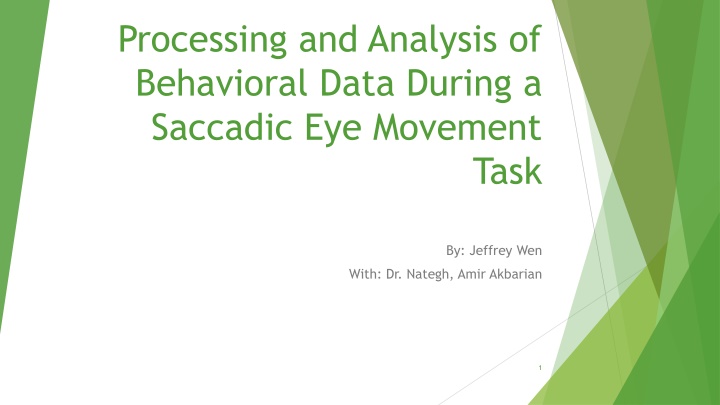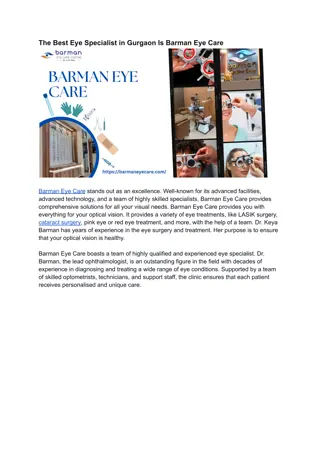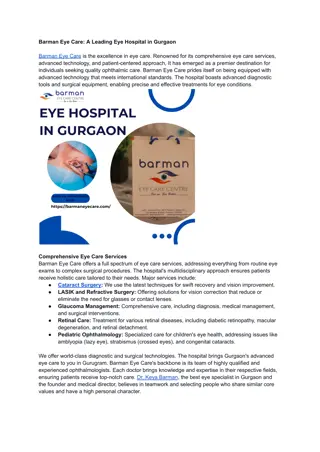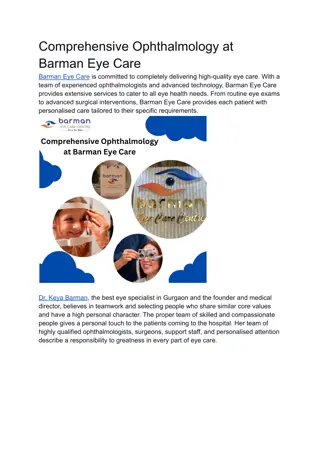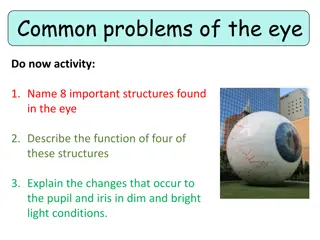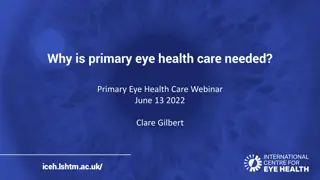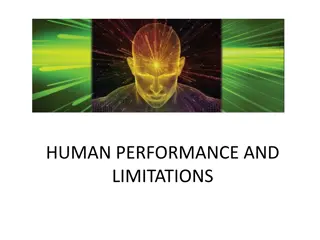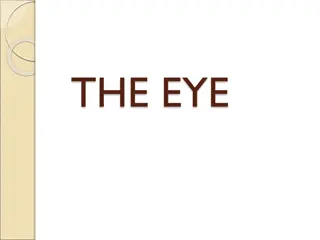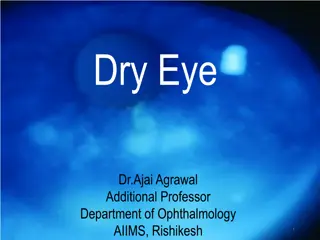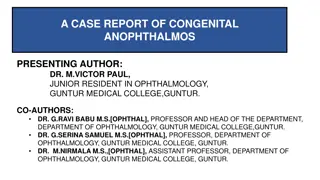Behavioral Data Analysis During Saccadic Eye Movement Task
Visual systems utilize saccades to focus on objects, impacting temporal perception. This study explores the effects of saccades and stimulus location on perceived time, presenting findings from an experiment on temporal perception mapping with fixed visual duration. The method of psychometric function analysis is employed to quantify these effects. Results show perceived time expansion during saccade fixation, with shifts in Point of Subjective Equality indicating temporal changes. Psychometric functions for stimuli display differences between perisaccadic and fixation periods, highlighting the role of eye movements in temporal processing.
Uploaded on Jul 29, 2024 | 2 Views
Download Presentation

Please find below an Image/Link to download the presentation.
The content on the website is provided AS IS for your information and personal use only. It may not be sold, licensed, or shared on other websites without obtaining consent from the author.If you encounter any issues during the download, it is possible that the publisher has removed the file from their server.
You are allowed to download the files provided on this website for personal or commercial use, subject to the condition that they are used lawfully. All files are the property of their respective owners.
The content on the website is provided AS IS for your information and personal use only. It may not be sold, licensed, or shared on other websites without obtaining consent from the author.
E N D
Presentation Transcript
Processing and Analysis of Behavioral Data During a Saccadic Eye Movement Task By: Jeffrey Wen With: Dr. Nategh, Amir Akbarian 1
Introduction Visual systems use rapid eye movements, saccades, to bring objects of interest into focus for further processing Previous studies have found different temporal and spatial phenomenon in perception during saccades Perceived Spatial Compression (Morrone et al,. 1997) Perceived Temporal Compression (Ross et al,. 2005) What effects in temporal perception can be seen with the comparison of perisaccadic visual stimuli and fixation auditory stimuli? Does the spatial location of stimuli play a role in temporal perception? 2
The Experiment: Temporal Perception Mapping with Fixed Visual Duration The Experiment: Signals Eye Position Target Fixation Fixation Target 1 2 3 4 5 6 7 Location Visual Stimuli Auditory Stimuli Goal: To examine the effects of saccades and stimulus location on perceived time Primary Deliverables: Plots illustrating the observed temporal effects and a literature-based hypothesis for the cause 3
Methods: Psychometric Function Psychometric Function: the relationship between a change in stimulus and a subject s response (a model used for quantifying detection or discrimination tasks) Obtained by fitting a Gaussian cumulative distribution function over the measured responses Point of Subjective Equality (PSE) the point which the subject is equally likely to answer one way as the other PSE 4
Results: Perceived Time Expansion During Saccade Fixation PSE = 143 ms Perisaccadic PSE = 182 ms Shift in PSE to the right: temporal expansion (34 ms) Shift in PSE to the right: temporal expansion (39 ms) Subject MC Subject RJ Psychometric Functions for Stimuli Psychometric Function for Stimuli Psychometric Functions for Stimuli 1 1 1 0.9 0.9 0.9 Proportion of Auditory Stimuli Longer Proportion of Auditory Stimuli Longer Proportion of Auditory Stimuli Longer 0.8 0.8 0.8 0.7 0.7 0.7 0.6 0.6 0.6 0.5 0.5 0.5 0.4 0.4 0.4 0.3 0.3 0.3 Fixation (> 200ms) Fitted Curve Perisaccadic (<= 200ms) Fitted Curve Point of Subjective Equality Fixation (> 200ms) Fitted Curve Perisaccadic (<= 200ms) Fitted Curve Point of Subjective Equality Visual Stimuli Duration 0.2 0.2 Fixation (> 200ms) Fitted Curve Point of Subjective Equality Visual Stimuli Duration Visual Stimuli Duration 0.2 0.1 0.1 0.1 0 0 0 5 100 100 150 150 200 200 250 250 300 300 100 150 200 250 300 Duration of Auditory Stimuli (ms) Duration of Auditory Stimuli (ms) Duration of Auditory Stimuli (ms)
Results: Psychometric Functions Across Time Relative to Saccade Allows us to see the change in PSE across time Maximum PSE occurs between 100ms to 50ms before saccade 6
Maximum PSE between 100ms and 50ms before Saccade Subject MC Subject RJ 7
Results: Temporal Effects as a Function of Spatial Location Target Fixation General Trends: Maximum or local maximum around Location 2 and 6 1 2 3 4 5 6 7 Location Minimum or local minimum around Location 4 Subject MC Subject RJ Change in PSE Based on Location 40 38 36 Change in PSE (ms) 34 32 30 28 26 24 1 2 3 4 5 6 7 Location 8
Results: Change in PSE Varies By Location Target Fixation Peaks at Location 2 and 6 Valley at Location 4 Maximums occur between 100ms to 50ms before saccade 1 2 3 4 5 6 7 Location 9
Verification: Temporal Perception Mapping Auditory Stimuli Fixed Same experimental setup except the auditory stimuli duration was fixed and visual stimuli duration was varied Same result of perceived temporal expansion Subject AA Subject MC Psychometric Functions for Stimuli Psychometric Functions for Stimuli 1 1 Proportion of Visual Stimuli Longer Proportion of Visual Stimuli Longer 0.8 0.8 0.6 0.6 0.4 0.4 Fixation (> 200ms) Fitted Curve Perisaccadic (<= 200ms) Fitted Curve Point of Subjective Equality Fixation (> 200ms) Fitted Curve Perisaccadic (<= 200ms) Fitted Curve Point of Subjective Equality 0.2 0.2 0 0 100 150 200 250 300 350 400 100 150 200 250 300 350 400 10 Duration of Visual Stimuli (ms) Duration of Visual Stimuli (ms)
Discussion Temporal expansion effect seen when the delay between visual stimuli occurs during saccade Visual Probe 1 The temporal expansion is similar to that seen during chronostasis Chronostasis is a perceived expansion of time after a voluntary action (Park et al., 2003) Start of Effect 200ms Delay Believed to be a result of the brain increasing the speed of its internal clock ticks during saccade (Park et al., 2003) Maximum Effect Additional experiments could tell if saccade size makes a difference or if expansion is proportional to the delay duration Visual Probe 2 End of Effect Saccade Window Previous studies have found auditory stimuli is perceived as longer than visual stimuli (Wearden et al., 2006) due to shorter internal clock ticks 11
Acknowledgements Dr. Nategh, Project Mentor Amir Akbarian, Project Mentor Dr. Repasky, REU Organizer Dr. Nakagawa, REU Organizer The National Science Foundation, Sponsor 12
